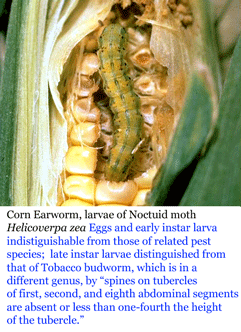 Among the 35,000 known species of noctuid moths, a number are destructive agricultural pests, including for example Corn earworm Helicoverpa zea and Tobacco budworm Heliothis virescens. Accurate identification is the essential first step in pest management, but morphologic identification can be difficult, particularly of eggs and larval forms.
Among the 35,000 known species of noctuid moths, a number are destructive agricultural pests, including for example Corn earworm Helicoverpa zea and Tobacco budworm Heliothis virescens. Accurate identification is the essential first step in pest management, but morphologic identification can be difficult, particularly of eggs and larval forms.
In September 2007 African Entomology, researchers from South Africa, Australia, and France analyze COI mtDNA of Busseola sp. larva in Ethiopian sugarcane. The DNA barcode region of COI was amplified from 7 morphologically-indistinguishable larval specimens using standard invertebrate primers (Folmer et al, Mol Marine Biol Biotech 3:294, 1994). Rearing of the larva was attempted, but none of the collected larva developed to the adult stage. Sequence analysis revealed two distinct clusters that matched sequences derived from adult B. fusca and B. phaia. Assefa and co-authors conclude “DNA-based methods were found to be a quick, easy and reliable method for identification of species…[and] may then be solutions for conditions in Africa where there is an acute shortage of experts and rearing facilities to keep field-collected insects alive until emergence of adults for morphological identification.”